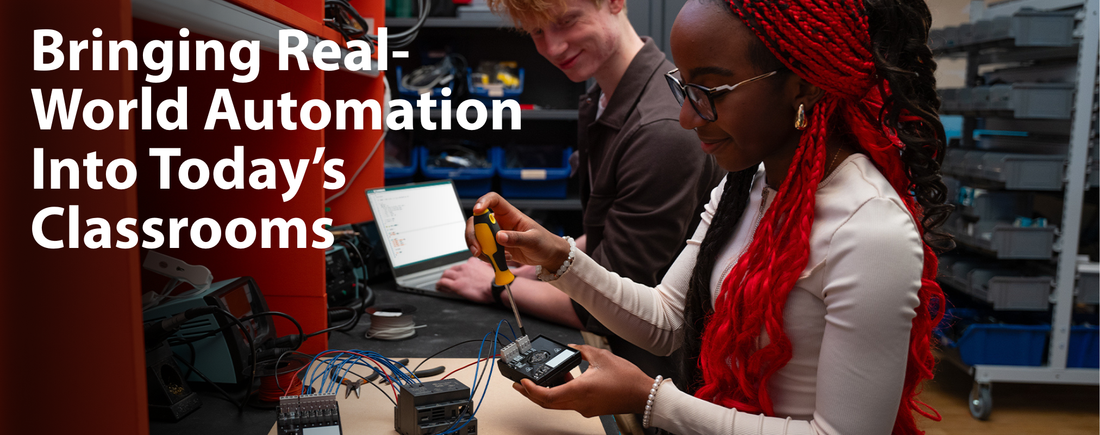In modern classrooms, preparing students for the future means helping them understand the systems that power the fast-paced world around them. Automation is a perfect example. While it might sound like it reduces the need for human input, the opposite is true. As industries rely more on automated processes, they also need people who know how to build, program, and interpret them.
That’s why career readiness today goes beyond reading about technology – it requires students to work with it. From programmable logic controllers (PLCs) to data-driven systems, students need hands-on opportunities to develop the problem-solving, coding, and technical skills that modern careers demand. And with the right resources, educators can bring these experiences to life – right inside the classroom.

Technically Speaking
Modern technology has transitioned our world to move beyond task efficiency and into task automation. Nowhere is this shift more visible than in manufacturing, which uses automated technology at nearly twice the rate of any other industry. And it’s not just because it can – automation through tools like programmable logic controllers (PLCs) improves quality control, reduces accidents by detecting hazards, and scales up production through smart monitoring.
Today’s economy relies on producing, communicating, and analyzing data on global scales – making automation more of a necessity than ever. According to the World Economic Forum’s 2025 Future of Jobs report, technological change is the top driver of business transformation. Among the five leading trends: information processing technologies, autonomous systems, and computing tech.
For students exploring engineering or technical fields, PLC fluency is more than useful, it’s essential. It gives them real-world experience and keeps their STEM education relevant to a contemporary workforce.
Programming Career Preparation
In Maryland, the need for workforce readiness is so pressing that local legislation is now funding technical education pathways – including Registered Apprenticeships – starting in high school.
Now imagine the advantage high school students gain with industry-recognized certifications in PLCs – these credentials open doors to careers in energy, oil, food processing, manufacturing, and beyond.
But bringing industry tools into the classroom isn’t always easy. Educators face challenges beyond just funding – like needing time, training, and ways to make complex systems understandable for students. Even experienced CTE educators can struggle to simplify advanced content without losing the real-world context that gives it value.
That’s why schools benefit from CTE projects that fit seamlessly into existing curriculum – solutions that connect students to career applications of STEM and support teacher facilitation.

The Right Resource Makes Learning Automatic
To explore what that kind of solution looks like, we hosted a webinar with thought leader Jason Strickland, who shared how Arduino Education is rewiring what’s possible in high school classrooms.
“Normally, PLC training requires a bunch of expensive parts that most teachers don’t have access to. Well, not anymore,” Jason explains.
With just a pair of screwdrivers and pliers, students can dive into hands-on exploration using Arduino’s PLC Starter Kit – a project-based resource that simulates a factory environment with real industry-grade equipment.
Designed for small groups to reflect real-world teamwork, the kit guides students through the entire PLC process—from history and foundations to programming using the five languages, including ladder diagrams (the most-widely used internationally). Aided by videos and diagrams, students wire the system’s core, the Opta, on their own.
“It’s even more valuable than a classroom-specific resource,” Jason adds. “This is a professional product. Students are using the same tools and processes real technicians use.”
Yet professional doesn’t mean inaccessible. The kit introduces high-demand skills in approachable ways, then gradually ramps up to advanced concepts like AI integration. From beginner coding to data monitoring, teachers can scale the difficulty as students grow.
It’s also flexible, which is perfect for a semester-long course or a focused unit. With step-by-step visuals, word-for-word lesson plans, and expert support on call, educators get the guidance they need to confidently let students take the lead.

A Solution Made to Last
In today’s job market, the ability to leverage technology is one of the most valuable skills a student can develop. With Arduino’s PLC Starter Kit, teachers get a durable, ready-to-use classroom tool, and students gain technical expertise that lasts a lifetime.
Ready to bring PLCs to your classroom? Watch the webinar now to see how it works in action, then browse our hands-on kits designed to prepare your students for real careers in STEM and automation.

